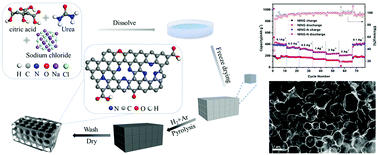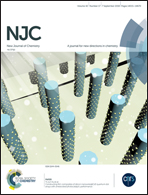Template-assisted in situ confinement synthesis of nitrogen and oxygen co-doped 3D porous carbon network for high-performance sodium-ion battery anode†
Abstract
Non-graphitic carbons have shown great advantages as anodes for sodium ion batteries. However, they deliver an unsatisfactory capacity, especially at high rate, owing to the sluggish sodiation kinetics. In this work, we synthesized well-distributed nitrogen and oxygen co-doped three-dimensional ultrathin amorphous porous carbon network via a simple NaCl template-assisted in situ confinement pyrolysis strategy. The porous carbon network with oxygen-containing groups provides abundant room (surface area of 282.78 m2 g−1) for the storage of Na+ and good wettability for the sufficient contact of the active material and the electrolyte, the affluent pores and the large interlayer space offer smooth passage for the insertion of Na+ and the transportation of electrons, and high-content nitrogen (N: 12.44 at%) doping affords more defects and active sites for the redox capacitance reaction of Na+. When used as an anode for sodium-ion batteries, the as-prepared sample presents high reversible capacity (416 mA h g−1 at 0.1 A g−1 after 100 cycles), superior rate capability (213.8 mA h g−1 at 5 A g−1), and excellent cycling performance at a super-high rate (142 mA h g−1 at 10 A g−1 after 1000 cycles with capacity retention of 94%). This work provides a new strategy to effectively construct continuous porous carbon nanostructures with uniform dual heteroatom doping for high-performance sodium-ion battery anodes.



 Please wait while we load your content...
Please wait while we load your content...